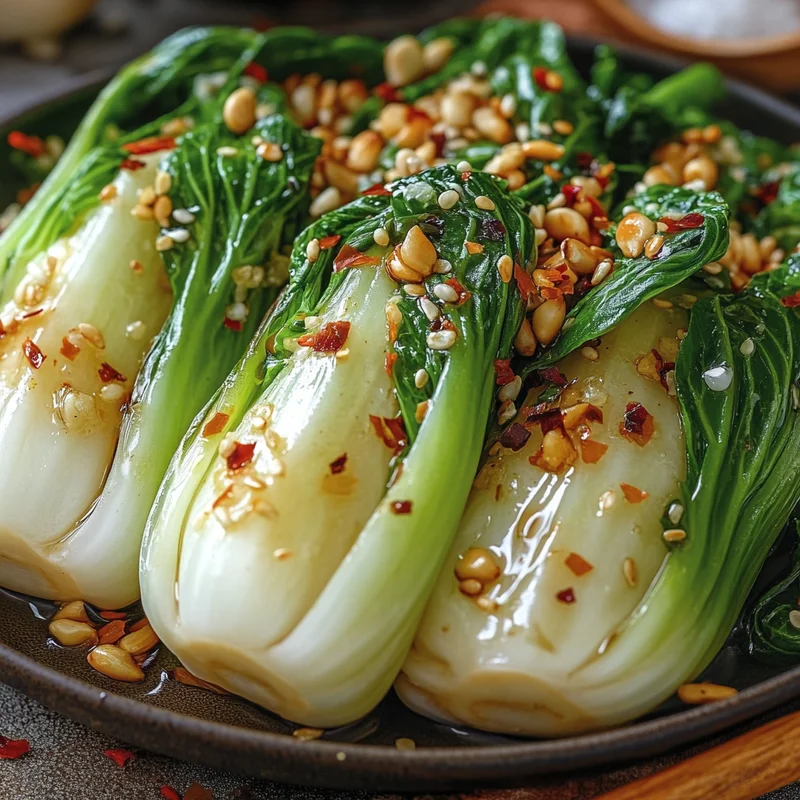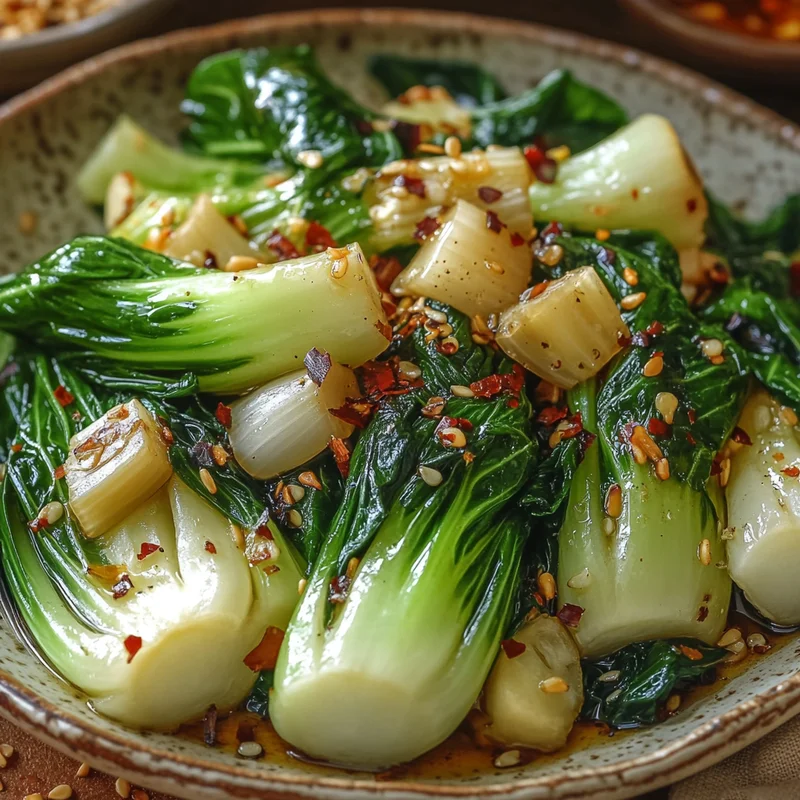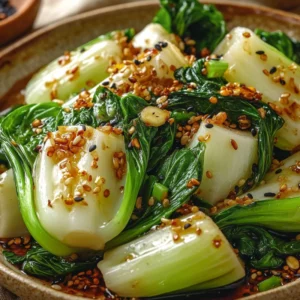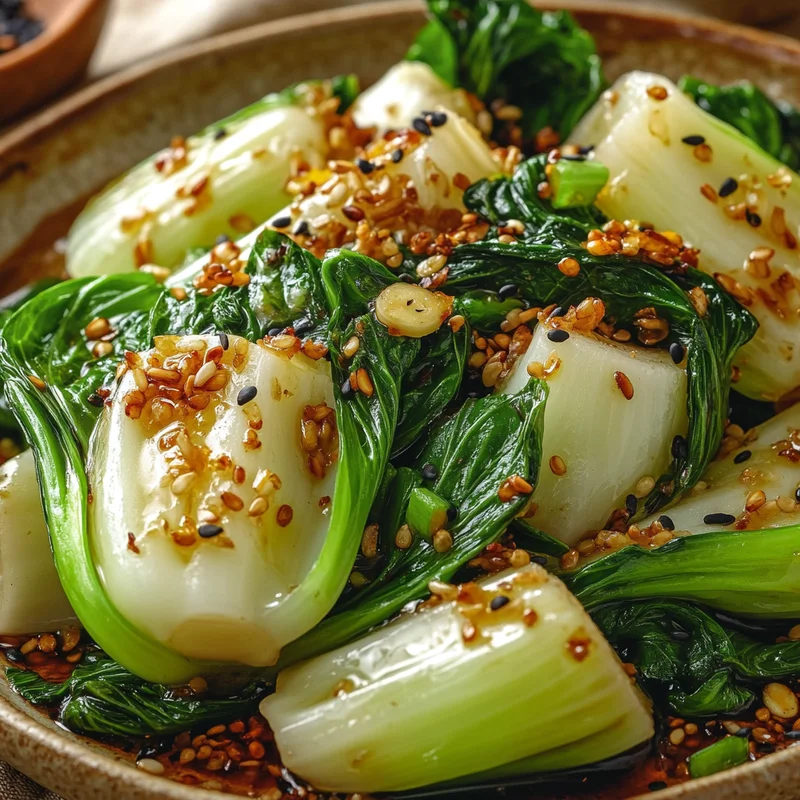Introduction
Hey there, friend! Are you constantly on the lookout for that perfect, quick side dish to round out a weeknight meal? Something that feels a little fancy, but is secretly ridiculously easy? Well, you’ve just found it! This Garlic Ginger Bok Choy recipe is my go-to when I need a burst of fresh flavor and a splash of green on the plate, fast. It comes together in under 10 minutes and tastes absolutely amazing. Trust me, once you try this simple sauté, you’ll be making it all the time!
Why You’ll Love This Recipe
Seriously, what’s not to love about a recipe that delivers big on flavor without taking up your whole evening? Here are just a few reasons this will become a staple:
- Fast: From start to finish, you’re looking at maybe 10 minutes. Perfect for busy nights!
- Easy: Basic pantry staples, minimal steps, maximum reward.
- Giftable: Okay, maybe not giftable like cookies, but it’s a fantastic, healthy-ish side to bring to a potluck or a friend’s dinner. It travels well!
- Crowd-pleasing: Even folks who are skeptical about greens often fall for the simple, savory deliciousness of this dish.

Ingredients
You don’t need a long list of exotic ingredients for this! Just a few simple things you likely have on hand or can easily grab at any grocery store.
- 4 baby bok choy: These little guys are perfect! Tender leaves and crunchy stems. Look for ones that are vibrant and fresh.
- 3 cloves garlic, minced: Don’t skimp on the garlic! It’s a star here. Freshly minced is best for maximum flavor.
- 1 tsp fresh ginger, minced: That little bit of ginger adds a wonderful warmth and zing that pairs beautifully with the garlic.
- 2 tbsp low-sodium soy sauce: This brings the savory umami. Using low-sodium lets you control the saltiness better.
- Salt and black pepper, to taste: You might not need much salt with the soy sauce, but always taste and adjust!
- 1 1/2 tbsp canola oil: A neutral oil with a high smoke point is great for stir-frying.
- 1 tsp sesame oil: This is added at the very end and provides that classic, aromatic Asian-inspired finish. Don’t substitute this!
How to Make It
Ready? Let’s get this deliciousness on the table in a flash. It’s seriously simple, just follow these steps:
First things first, let’s get our bok choy ready. Give those baby bok choy a really good wash. Sometimes dirt can hide in the bases, so get right in there under running water. Once they’re clean, shake off the excess water and cut each one in half lengthwise. If they’re a little bigger, you can quarter them. This helps them cook evenly and makes them easy to eat.
Now, grab your wok or a large pan. We want something that gets hot and has enough space for the bok choy. Heat the canola oil over medium-high heat. You want it shimmering but not smoking.
Time for the aromatics! Add your minced garlic and ginger to the hot oil. Stir-fry them for about 30 seconds. You’ll know they’re ready when your kitchen starts smelling amazing and fragrant. Be super careful not to burn the garlic – it can go from perfect to bitter in seconds!
Next, toss the prepared bok choy into the pan. Give it a good stir-fry for 2-3 minutes. You’ll see the bright green leaves start to wilt down, and the thicker white stems will begin to look slightly translucent but still have a nice crispness.
Pour in the low-sodium soy sauce. Stir everything together so the bok choy gets coated in that savory goodness. Keep cooking for another 1-2 minutes, just until the bok choy is cooked to your liking. I like my stems tender-crisp, not mushy!
Almost done! Take the pan off the heat and drizzle that wonderful sesame oil over the top. Give it one last gentle stir. Now is the time to taste! Add a pinch of salt if needed (remember the soy sauce is salty!) and some freshly ground black pepper.
Serve it up immediately while it’s hot and vibrant! It’s a fantastic side for rice dishes, noodles, or any protein.
Substitutions & Additions
This recipe is super flexible! Feel free to play around based on what you have or what you’re craving:
- Other Greens: Can’t find bok choy? Try this method with gai lan (Chinese broccoli), or even just regular broccoli florets (you might need to cook them a little longer).
- Different Oil: Grapeseed oil or peanut oil work well in place of canola for stir-frying. Olive oil isn’t ideal for high heat here.
- Make it Spicy: Add a pinch of red pepper flakes along with the garlic and ginger, or drizzle with some sriracha at the end.
- Add Protein: Cook some sliced chicken, shrimp, or tofu cubes first, remove them, cook the bok choy, then add the protein back in at the end.
- A Touch of Sweetness: A tiny pinch of sugar or a drizzle of honey can balance the savory soy sauce.

Tips for Success
Even simple recipes have little tricks that make them perfect. Here are a few things I’ve learned:
- Don’t Overcook: Bok choy cooks fast! You want the leaves wilted but the stems still slightly crisp. Overcooked bok choy is sad bok choy.
- Hot Pan is Key: Make sure your pan and oil are hot before adding the garlic and ginger. This is crucial for that quick stir-fry effect.
- Watch the Garlic: Burnt garlic is bitter. Keep a close eye on it in that first 30 seconds and keep it moving!
- Prep Ahead: You can wash and cut the bok choy, mince the garlic and ginger ahead of time, and keep them in separate containers in the fridge. When it’s dinner time, it’s just dump and stir!
- Dry Bok Choy: Try to get your washed bok choy as dry as possible before adding it to the hot oil to avoid splattering and steaming instead of stir-frying. A salad spinner works wonders!
How to Store It
While this dish is definitely best eaten right away, you can store leftovers. Let it cool completely, then transfer to an airtight container in the refrigerator. It will keep for 2-3 days. The stems might soften a bit upon reheating.
FAQs
Got questions? Here are a few common ones:
- Can I use mature bok choy? Yes, you can! You’ll just need to separate the leaves from the stems as the stems are much thicker. Cook the stems for a few minutes first, then add the leaves and proceed with the recipe.
- Is this dish gluten-free? As written, no, because of the soy sauce. To make it gluten-free, substitute the soy sauce with tamari.
- Can I use dried ginger? Fresh ginger is really recommended for the best flavor here, but if you’re in a pinch, you could try a very small amount of ground ginger (maybe 1/8 tsp) added with the garlic, but the flavor will be different.

Easy Garlic Ginger Bok Choy
Equipment
- Wok or large pan
Ingredients
Ingredients
- 4 baby bok choy Look for ones that are vibrant and fresh.
- 3 cloves garlic minced, Freshly minced is best
- 1 tsp fresh ginger minced
- 2 tbsp low-sodium soy sauce
- Salt to taste
- black pepper to taste
- 1.5 tbsp canola oil A neutral oil with a high smoke point
- 1 tsp sesame oil added at the very end, Don't substitute this!
Instructions
- First things first, let's get our bok choy ready. Give those baby bok choy a really good wash. Sometimes dirt can hide in the bases, so get right in there under running water. Once they're clean, shake off the excess water and cut each one in half lengthwise. If they're a little bigger, you can quarter them. This helps them cook evenly and makes them easy to eat.
- Now, grab your wok or a large pan. We want something that gets hot and has enough space for the bok choy. Heat the canola oil over medium-high heat. You want it shimmering but not smoking.
- Time for the aromatics! Add your minced garlic and ginger to the hot oil. Stir-fry them for about 30 seconds. You'll know they're ready when your kitchen starts smelling amazing and fragrant. Be super careful not to burn the garlic – it can go from perfect to bitter in seconds!
- Next, toss the prepared bok choy into the pan. Give it a good stir-fry for 2-3 minutes. You'll see the bright green leaves start to wilt down, and the thicker white stems will begin to look slightly translucent but still have a nice crispness.
- Pour in the low-sodium soy sauce. Stir everything together so the bok choy gets coated in that savory goodness. Keep cooking for another 1-2 minutes, just until the bok choy is cooked to your liking. I like my stems tender-crisp, not mushy!
- Almost done! Take the pan off the heat and drizzle that wonderful sesame oil over the top. Give it one last gentle stir.
- Now is the time to taste! Add a pinch of salt if needed (remember the soy sauce is salty!) and some freshly ground black pepper.
- Serve it up immediately while it's hot and vibrant!

